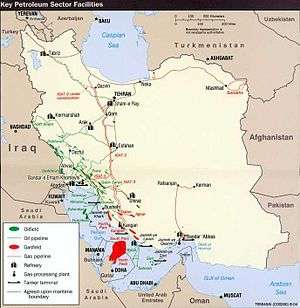Fordow Fuel Enrichment Plant
| Part of a series on the |
| Nuclear program of Iran |
|---|
 |
| Timeline |
| Facilities |
| Organizations |
| International agreements |
| Domestic laws |
| Individuals |
| Related |
Fordow Fuel Enrichment Plant (FFEP) is an uranium enrichment facility located 20 miles (32 km) northeast of the Iranian city of Qom, near Fordow village.[1] The site was revealed in September 2009.[2] It is the second Iranian uranium enrichment facility, the other one being that of Natanz.
In January 2012 the International Atomic Energy Agency (IAEA) announced that Iran had started producing uranium enriched up to 20% for medical purposes and that material "remains under the agency's containment and surveillance.”[3]
Google Maps satellite images for the Fordow site can be found at coordinates 34.885649,50.99669. Images zoomed to the 20 meter level show a large double fence perimeter border erected around the site with towers located every 25 meters. Six 10 meter wide entry portals to the complex are located within the fenced area, as well as several buildings, the largest of which is approximately 5,500 square metres (59,000 sq ft).
Iranian authorities state the facility is built deep in a mountain because of repeated threats by Israel to attack such facilities, which Israel believes can be used to produce nuclear weapons.[4] However, attacking a nuclear facility so close to the city of Qom which is considered so holy between Shia Muslims brings concern of a potential risk of a Shiite religious response.[5]
In November 2013, hundreds of Iranians, mostly students of Sharif University of Technology, accompanied by Head of the Atomic Energy Organization of Iran, Ali Akbar Salehi, and several Majles (parliament) representatives formed a human chain around Fordow uranium enrichment facility.[6][7]
The Fordow plant was to be restructured to less intensive research use, as part of the Joint Comprehensive Plan of Action of April 2015.
Under the terms of the nuclear agreement with Iran, two-thirds of the centrifuges inside Fordo have been removed in recent months, along with all nuclear material. The facility is banned from any nuclear-related work and is being converted to other uses, eliminating the threat that prompted the attack plan, at least for the next 15 years.
— NYT, Feb. 16, 2016[8]
In 2016, Iran stationed anti-aircraft S-300 missile system at the site.[9]
See also
References
- ↑ "Russia 'regrets' reported Iran nuclear activity in Qom facility". =Haaretz. January 10, 2012.
- ↑ Iran ready to co-operate on nuclear programme, says Ahmadinejad, The Guardian
- ↑ "Iran enriching uranium at Fordo plant near Qom". BBC. 10 January 2012. Retrieved 1 March 2012.
- ↑ Azmat Khan (January 13, 2012). "Did Santorum Suggest Iran Wants Nukes to Bring Back Messiah?". Public Broadcasting Service.
- ↑ Akluf Benn (September 3, 2009). "Cries of 'hold me back' may lead Israel to strike Iran". Haaretz.com.
- ↑ "Iranian university students form human chain around Fordo nuclear facility". irna.ir. Retrieved 11 September 2015.
- ↑ "Farsnews". farsnews.com. Retrieved 11 September 2015.
- ↑ DAVID E. SANGER and MARK MAZZETTI: U.S. Had Cyberattack Plan if Iran Nuclear Dispute Led to Conflict
- ↑ http://www.jpost.com/Middle-East/Irans-rapid-deployment-of-S-300-to-Fordow-reveals-importance-of-site-466425
External links
- Videos
